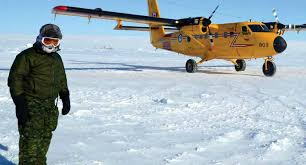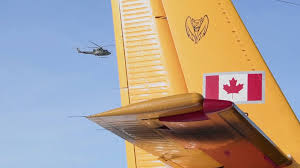You want a Tag that has seen it all? Well then Edition 12 is just right for you. Introducing the all mighty "Twin Otter". From serving passengers to carrying cargo to flying medevac, the "Twin Otter" is unstoppable.
Our "Twin Otter" is S/N 805, which is part of the 440 Transport Squadron. The 440 Squadron is a unit of the Canadian Armed Forces under the Royal Canadian Air Force. It is part of 8 Wing and works closely with the Joint Task Force located in Yellowknife, Northwest Territories. Based at Yellowknife Airport and operating throughout Northern Canada, the unit's primary role is to provide support to the Canadian Forces, including the Canadian Rangers And the Royal Canadian Air Cadets, with Search and Rescue as a secondary role. The squadron operates four CC-138 DHC ‘Twin Otter’ aircraft.
Today, only four RCAF Twin Otters remain in service with 440 Transport Squadron out of Yellowknife, NT – 13802, 13803, 13804, and 13805 – all four having originally entered service in 1971. Our ‘Twin Otter” 13805 is still flying today and will continue to fly for many more years.
The aircraft's fixed tricycle undercarriage, STOL capabilities, twin turboprop engines and high rate of climb have made it a successful commuter airliner, typically seating 18–20 passengers. With a little reconfiguration to the landing gear, the "Twin Otter" can go from landing on asphalt, gravel, snow and even water!
She is an adaptable bush plane for remote and northern areas. Areas including Canada and the United States, (specifically Alaska) had much of the demand. Many Twin Otters still serve in the Arctic and Subarctic, but they can also be found in Africa, Australia, Asia, Antarctica, and other regions where bush planes are the optimum means of travel. Their versatility and maneuverability have made them popular in areas with difficult flying environments
The DHC-6 starts her story with De Havilland Canada. It was 1964 when the development of the "Twin Otter" first started which was simply due to replacing the already existing DHC-3, or also known as the "Otter". On May 20th 1965 The legendary "Twin Otter" took flight for the very first time, which would soon become one of the most practical aircrafts in the world.
The new and improved "Twin Otter" had many changes done on it compared to the DHC-3. Some things include adding the double-slotted trailing-edge flaps and ailerons that work in unison with the flaps to boost STOL performance. Not to mention adding two 550 shaft horsepower (410 kW) Pratt & Whitney Canada PT6A-20 turboprop engines which made her more feasible.
The first 6 produced were prototypes with MSN 1 being displayed at the Canada Aviation and Space Museum, after MSN 115 production and design was slightly modified up to MSN 200.
Some modifications included improving the STOL performance, adding a longer nose that was equipped with a larger baggage compartment (except for aircraft fitted with floats), and fitting a larger door to the rear baggage compartment. All Series 1, 100, and 200 aircraft and their variants (110, 210) were fitted with the 550 shp (410 kW) PT6A-20 engines.
Past MSN 200 up to and including MSN 300 there was another slight change to Design and production which included fitting more powerful PT6A-27 engines. This was a 680 hp (510 kW) engine that was flat rated to 620 hp (460 kW) for use in the Series 300 Twin Otter. The Series 300 proved to be the most successful variant by far.
In the early to mid 70's a "Twin Otter" would cost you around $700,000 USD after the "Twin Otter" proved herself through the years there was a much higher demand for her, which raised her price averaging at around 2.5 to 3 Million. De Havilland Canada stopped production of the DHC-6 in 1988, however after British Columbia based "Viking Air" purchased the type certificate in 2008, production restarted. In 2022 Viking Air re adopted the legendary name "Twin Otter". During this time Viking Air was also producing parts for all of the out of production DHC-6.
On 17 July 2006, at the Farnborough Airshow, Viking Air announced its intention to offer a Series 400 Twin Otter. On 2 April 2007, Viking announced that with 27 orders and options in hand, it was restarting production of the Twin Otter, equipped with more powerful Pratt & Whitney Canada PT6A-34 engines.As of November 2007, 40 firm orders and 10 options had been taken and a new final assembly plant was established in Calgary, Alberta. Zimex Aviation of Switzerland received the first new production aircraft, serial number 845, in July 2010.By mid-2014, Viking had built 55 new aircraft at its Calgary facility. The production rate as of summer 2014 was about 24 aircraft per year. In April 2015, Viking announced a reduction of the production rate to 18 aircraft per year. On 17 June 2015, Viking further announced a partnership with a Chinese firm, Reignwood Aviation Group. The group will purchase 50 aircraft and become the exclusive representatives for new Series 400 Twin Otters in China.
Major changes introduced with the Series 400 include Honeywell Primus Apex fully integrated avionics, deletion of the AC electrical system, deletion of the beta backup system, modernization of the electrical and lighting systems, and use of composites for non load-bearing structures such as doors.
Twin Otters are also a staple of Antarctic transportation.Four Twin Otters are employed by the British Arctic Survey on research and supply flights, and several are employed by the United States Arctic Program via contract with Kenn Borek Air. On 24–25 April 2001, two Twin Otters performed the first winter flight to Amundsen-Scott South Pole Station to perform a medical evacuation. On 21–22 June 2016, Kenn Borek Air's Twin Otters performed the third winter evacuation flight to Amundsen–Scott South Pole Station to remove two people for medical reasons. On 26 April 2001, the first ever air rescue during polar winter from the South Pole occurred with a ski-equipped Twin Otter operated by Kenn Borek Air.
In 1971 The Canadian Air Force purchased 9 "Twin Otters" which have been serving in the most harsh remote parts of Canada up to date. In 2017 the Canadian government had plans to replace the ageing "Twin Otters" however instead decided it would be best to put them through a life extension program. This process required several parts to be removed and replaced which included both wings to be replaced. Because of this the "Twin Otters'' would now be able to fly to at least 2025 and the Plane Chains crew were able to acquire one of the 805 wings to upcycle into keychains for enthusiasts who like a tag that has a great story and that has been to the most remote parts of the world.
The ‘Twin Otter’ is one of the most successful Canadian-built aircraft in history. As many as 844 were delivered to customers in 76 nations. Which is why it will stick around for many years to come and will continue to help many people in any part of the world.







































